“The most Calamitous railway disaster in the history of Great Britain, both in overwhelming magnitude and the horror of the scenes that followed, occurred on Saturday morning on the Caledonian Railway, half a mile north of Gretna Junction”
Dumfries & Galloway Standard & Advertiser, 28 May 1915.
May 1915. It was less than a year since the start of the war and the conflict had become bogged down in the mud and trenches of France and Belgium. On the 9th May heavy casualties were sustained at the Battle of Aubers ridge, the failure to make any gains further compounded by a shortage of shells “British Soldiers died last week on Aubers Ridge because the British Army is short of shells” complained the Commander in Chief of the BEF Sir John French, with The Times newspaper taking up the story. Prime minister Herbert Asquith’s Liberal government was soon in political crisis over this. Compounding matters, Winston Churchill’s plan to break the deadlock by invading the Gallipoli Peninsular in Turkey in April 1915 had also stalled and was suffering horrific casualties. The country was in a crisis and in the middle of this, on a sunny May morning at a stretch of the main Caledonian railway at Quintinshill signal box, near the town of Gretna Green, a further catastrophe was to occur when a train carrying 485 Royal Scots Guards troops to Liverpool for embarkation on a ship bound for Gallipoli ploughed head on into a stationary passenger train. A minute later an express train from London, bound for Glasgow, ploughed into the wreckage of these two trains. This was, and remains, the worst rail disaster in British railway history.
“What’s the matter this morning up the Cally?”
On 7:00am Saturday 22nd May 1915 young Thomas Straiton left his home at the cottages at Gretna junction to go to work at a nearby farm. A couple of minutes later he caught up with his grandfather, an employee on the railway, who was stood watching as a man came running down the tracks with a red flag. His grandfather shouted “What’s the matter this morning up the Cally?” (The “Cally” being the Caledonian Railway) The reply came “There’s been a terrible accident at Quintinshill, there’s a troop train run into a passenger (train)” He went on to say “My express (train) has run into them both, the debris is piled sky high, there’s bound to be dozens killed” He then carried on running down the track to the Gretna Junction box. Thomas’s grandfather headed off to Gretna Green to tell his colleagues about the crash and young Thomas ran in the direction of Quintinshill to assist with the rescue.
Quintinshill signal box is located near Gretna Green in a fairly remote rural location in the Scottish borders, not far from the border with England. Quintinshill signal box controlled two what were called “passing loops” or “sidings” where trains travelling in the same direction can overtake, one loop each side of this mainline of track running between Glasgow to the north and Carlisle to the south. During the First World War there were a number of railway companies involved in running Britain’s rail network with trains, tracks, stations and signal boxes falling under different ownerships causing bottlenecks and delays, so these loops and sidings were created to alleviate these issues and it was the job of the railway employees in the signal boxes to control the flow of the railway traffic and ensure that things ran smoothly with few delays. If a faster express train was approaching behind a slower goods train the goods train could be pulled over into the siding or loop to allow the faster train to pass. If a loop or siding was occupied, then a train could be “shunted” or moved into an opposite line to allow a faster train to pass.
Early morning on 22nd May two express trains were running late, one heading to Edinburgh and the other to Glasgow, and there was a local train which had left Carlisle at 6:17am and was heading north.
At Quintinshill Junction an empty goods train was in the north bound siding, which was the siding into which the local train would ordinarily have been directed and instructed to wait to allow the express train to pass. As the north bound siding was occupied by the goods train and the south bound siding was occupied by an empty coal wagon, the local train was shunted on to the southbound main line where it was to be held until the faster express trains, which had priority, had passed by. At 6:38am the Edinburgh north bound express train passed through on the northbound line and continued on its way, passing the south bound troop train going in the opposite direction. At 6:47am the southbound troop train thundered towards Quintinshill on the southbound line and rounded the bend in the track. The driver, Francis Scott, was faced with a terrible sight. He was face to face with another locomotive on the same track, this was the local train still waiting on the southbound line. He did his best to apply the brakes as the driver and the fireman of the local train jumped clear. At 6:49am the troop train hit the local train at an estimated speed of 40mph. Scott and his fireman were killed instantly. The soldiers in the wooden carriages were hit by wooden splints and shards of metal as well as their own equipment dislodged from the train, many died instantly and many more were injured but many were also trapped. With the force of the collision a train that had been over 200 yards in length was compressed to less than half of that. Miraculously only two people died on the local train, the others managing to escape, mainly because the force of the collision had pushed the carriages clear and back down the track.
Worse was to follow only two minutes later. The late London to Glasgow sleeper express train had made up time and, despite the best efforts of the guard of the local train who ran down the tracks to try and warn the driver of the express train, other than furiously applying the brakes there was little the driver of the express train could do. Although it had managed to slow to 50mph, the express train ploughed into the wreckage of the troop train and the local train. The noise of the impact was such that a local woman thought that the Germans had invaded.
Miraculously only seven people died in the much newer express train with its superior construction. This three train crash caused wreckage to smash into the two freight trains in the passing loops so taking the number of trains involved to a total of five.
When young Thomas Straiton reached Quintinshill junction he was met with a scene of utter carnage and he joined two other men who were first on the scene in trying to assist with the rescue operation. They started to cut through the wooden wreckage and pull the injured to safety and remove the dead but by now a fire had taken hold.
“Troublesome Trucks”
At this time virtually everything was transported by rail and canal and the demands of the war in terms of getting men and material to ports destined for transportation overseas had increased pressure on the overcrowded railways which was not alleviated by any reduction in the running of other passenger trains. Despite the movement of men and equipment being an obvious wartime priority, there was no co-ordinated approach to managing this logistically. The capacity of the tracks and the availability of rolling stock were a huge problem and so rail companies tended to use whatever stock was available at the time regardless of its suitability. Slow antiquated goods trains that frequently broke down and caused issues on the line were forced into use, forever immortalised as the “Troublesome Trucks” in the Thomas the Tank Engine children’s story as they could indeed prove “troublesome”. As one local historian put it “with the wartime shortage of stock, almost anything on wheels was acceptable”
The troop train was made up of 15 carriages, an assortment of 50 year old wooden bodied coaches with timber underframe, a form of construction that had been obsolete for a very long time. Whenever the train picked up speed the carriages lurched from side to side, so much that the luggage fell from the rack.
More critically perhaps, the method of lighting within the carriages was via high pressure gas stored in cylinders. The troop train also had been slowed by freight trains on the line and was running 22 minutes late but had increased speed by the time it had passed Lockerbie, the engine was much newer than the old wooden carriages it was pulling.
“no battlefield could have surpassed the scenes of carnage and destruction”
The real horror of this incident was not simply down to the two collisions which were bad enough in themselves but it was what happened next. The wooden carriages of the troop train were fuel for the fire that started and was assisted by the gas cylinders of the lighting system exploding. Burning coals from the locomotive engines ignited the gas and soon an inferno raged with men trapped in the wreckage shouting and begging for help.
Those who arrived on the scene from local farms to assist were armed with axes and farming implements but what was needed was water and none was available apart from that in the engines of the destroyed locomotives. The location of the crash was rural and isolated so it was not until over an hour after the crash that the first official rescue train arrived from Carlisle by which time the blaze had fully taken hold. The firemen arrived an hour after that although they could have made little difference given the speed at which the fire took hold. More rescue parties such as medics had been sent on other trains but some of these were held up for various reasons.
Many of the trapped men suffered terrible injuries and as they had no hope of rescue as the fire approached, they begged for their officers to end their suffering with a bullet and corroborated stories suggest that officers complied.
At the inquest into the disaster a local farmer gave his witness testimony
“the terrible cases…of men who had been scorched by the flames and were suffering agonies that we could not alleviate, for no one could get near them, and even if they could have done so, rescue would have been impossible owing to the wreckage beneath which they had been buried. These men were in the death throes and so terrible was the agony they were undergoing that they were praying for their would-be rescuers to shoot them and thus end their misery”.
Trapped men were also witnessed ending their own lives with a blade and amputations were carried out to free men whose limbs were trapped by the wreckage. Eventually doctors arrived on the scene had brought medical equipment, chloroform and morphine and had to carry out these operations under the worse conditions imaginable with one witness reporting,
“surely was never such an operation carried out under such terrible circumstances. I am not exaggerating when I say that the doctors worked in momentary danger of their lives. Very close to them the fire was raging. While they worked, the flames were beginning to lick the outside of two gas cylinders two yards away. The railway men levered the wreckage as much as they could to allow the doctors to perform their work”
By mid-morning all hope of finding any survivors was gone. Initially the dead and wounded were laid in the field as doctors and volunteers tended to them and farm buildings close by were taken over as temporary mortuaries before teams of undertakers organised the transfer of the remains. It was not always a case of a single body per casket, some were filled with the remains of more than one as so little could be reclaimed from the fire.
“The heap of ruins on the line were still on fire, and the smoke which spread itself like a pall over the scene, smelt of more than just smouldering wreckage. It was tainted with the odour of burning flesh and bones, sickening, nauseating, one felt that it could only last a little longer than the nightmare would pass “
Dumfries and Galloway Standard and Advertiser 28 May 1915.
The undamaged rail cars of the express train were used as a makeshift ambulance as trains transported the most seriously injured to Carlisle and Glasgow, again though the infrastructure couldn’t cope with such a high number of seriously wounded and when stretchers ran out wheelbarrows, ladders and planks were used to convey the injured to the hospitals. The death toll grew as many did not survive the journey “Carlisle was like a front line city as red cross wagons rumbled through the streets with loads of bandaged and bloodied soldiers” wrote one eye witness
As one eye witness stated “no battlefield could have surpassed the scenes of carnage and destruction”
The treatment of the survivors seems callous by our standards, they were transported to Carlisle and allowed to wash and given food and to rest, but not for long. At 2am they were expected to be on parade to salute a passing lieutenant general who was on his way to Scotland and then they were to be transported down to Liverpool, their destination was still Gallipoli. These men, who only the previous day had witnessed the death of many of their comrades and had themselves narrowly escaped death in a train crash, were transported by train. “It was a nightmare trip, our nerves were shattered and every time the train slowed or took a corner we gasped and braced ourselves for the worst”
On arrival in Liverpool they were put to sorting out their kit all salvaged from the disaster “I am quite sure that there was flesh stuck to some of it” noted one officer. Finally, word came down from HQ that none of these survivors, apart from 7 officers, were deemed fit to go. It was harsh on the 7 officers. Those deemed not fit for Gallipoli were again put on a train, this time destined for home and Edinburgh’s Craigleith hospital for recuperation.
Back at Quintinshill the track was cleared by the Sunday night ready for trains to run again but unfortunately the accident had attracted the ghoulish spectators and looters with these getting in the way of the clearance work, some of them not even thieves, just people looking for items as keepsakes. These were souvenir hunters of the worst kind.
In Leith the fear and heartbreak was palpable, special trains were put on to allow relatives to visit the injured in hospital, only for those who had received word that their loved one was in hospital. Those not notified were asked not to attempt to travel. Another train came into Edinburgh transporting the dead home. It took 3 hours for the funeral procession to reach Rosebank cemetery in Leith where the caskets were buried in a common grave as many of the dead could not be identified. A year later the cost of the memorial had been met by public subscription and the panels on it list the names of the 214 men of the 7th Royal Scots who died at Quintinshill that day, including those whose remains could not be identified or whose remains were never found. Seven people on the express train lost their lives, a small number which was testament to the newer safer steel framed construction of the carriages. A further two people died on the local train including a 2 year old boy. The official number of injured was listed as 246.
The Inquiries into the disaster
“I forgot about it after I jumped off the engine and it never entered my mind again until after the accident had happened” (Signalman James Tinsley at the Board of Trade enquiry 25th May 1915)
An inquiry was held shortly after into what had caused the crash and the guilt was firmly placed on James Tinsley, “the signal man who forgot about a train”
On Friday 21st May at 8:00pm signalman George Meakin arrived for his shift which was to finish at 6am when Tinsley was to take over. By 6:14am Meakin had directed the two freight trains into the north and south loops and, having been told that the local train was just in front of the northbound express train, he had limited options so he shunted the local train onto the south bound line to allow the express train to pass on the northbound line. Delaying an express train to allow a local train through was not an option and his two loops were occupied by freight trains. Once the express train had passed by, the local train could be returned to the north bound line and sent on its way, a task Tinsley should have carried out when he took over from Meakin at 6:00am. However, Meakin and Tinsley had been unofficially operating a slightly relaxed system of working hours which allowed Tinsley to start work up to half an hour late. In order to hide this they faked the paperwork, Meakin would note down all train movements between 6:00am and whatever time Tinsley started on a piece of paper and Tinsley would simply copy this down in the official register so it appeared from the change of handwriting that he had started work at 6:00am. Meakin explained the situation with the local train to Tinsley when he started work just after 6:30am. To make matters worse, Tinsley had actually come to work on the local train and hopped off it at Quintinshill, another breach of company regulations.
At 6:42am Tinsley made the error of “accepting” the troop train, allowing it to enter the Quintinshill junction on the southbound line. If Tinsley had looked out of the window of his signal box he would have seen the local train sitting there. Simple forgetfulness was one reason put forwards for this, but could he have been distracted by an animated conversation in the signal box when two other railway men had joined him and Meakin there? Or was he distracted by furiously writing up the forged leger from the notes that Meakin had left him? Or was there some other reason?
As the troop train ran into the local train Tinsley panicked. He still had time to signal for the northbound express train to stop but failed to do so. Meakin tried his best but was too late. It was now essential for messages to be sent to neighbouring signal boxes to close the line but again Tinsley, apparently completely paralysed with shock, failed to do so. It appears from the register that these messages were only sent at 6:53am, just as the northbound express train ploughed into the wreckage of the troop train and the local train.
Both a public inquiry and a Board of Trade inquiry were opened. The following Friday Inspector Morrison arrived to arrest Tinsley but found “when constables went to apprehend Tinsley yesterday they found him unwell, apparently. His own medical attendant said he had epileptic fits since the collision – these might develop into acute mania and he could only be removed in an ambulance” Interestingly this mention of epilepsy was only briefly noted in the inquiry with the Scotsman newspaper reporting ”Tinsley was the signalman on duty when the accident happened. He was arrested at home and, as the man is subject to fits, he was conveyed to the police headquarters in an ambulance”
If he had epilepsy the Caledonian Railway would have come under scrutiny for employing him, the lack of supervision allowing him to start late was bad enough and something which Meakin had no choice but to admit to under cross examination.
Although much of Tinsley’s testimony was confused it was now that he made the statement that he had simply forgotten about the local train on the southbound line, a train he had alighted only some half an hour earlier. Colonel Druitt heading the inquiry did not pursue the reasons for Tinsley’s confusion and memory lapses in the course of his questioning.
“a systematic failure of the Caledonian railway”
Anonymous letters to the Dumfries and Galloway Standard & Advertiser hinted that the cause could be attributed as much to a systematic failure of the Caledonian railway as the actions of the signalmen – the pulling over of the local train as the express had priority “signal men were harassed about detentions (delays), some of even a single minute, to trains, and how they are harassed with circulars and supplementary applications of rules and instructions” and “no doubt the officials of the Caledonian company never dreamed of the extent of the laxity that has prevailed” the letter writer went on to say “it is hoped that this terrible accident will productive of the good – that travelling will be made safer than it is today. One way in which it could be accomplished would be for the railway companies only to have rules that they intend to be carried out and to see that they are rigidly enforced”
Unlike the press reports and the original hearing that suggested Tinsley was unwell and suggested the management and inspection/supervision of its staff was questionable, the final report did not mention this and put the cause of the crash firmly on Meakin and Tinsley. There would be good reason for this, further investigation may have brought to light other incidents of malpractice on the railway and questions would be asked about whether the national railway was up to its task of underpinning the war effort, something that may have further dampened morale at this critical period of the conflict. The railways came under the control of the railway executive committee set up by parliament on the outbreak of war. There can be little doubt that the interests of the shareholders and Government was foremost in the mind of the Caledonian Railway directors in the wake of the accident.
The June 1915 inquest unsurprisingly found Tinsley, Meakin and Hutchinson, the fireman on board the local train, guilty of manslaughter which equally unsurprisingly went down badly in Scotland with the trial being held in England. The men were now arrested in Scotland with a trial to be held in Scotland.
“It would not have been criminal negligence if he had fallen down in an epileptic fit” stated James Condie Sandeman, KC, defence advocate, at the high court trial on 15th September 1915 where as far as the Lord Advocate was concerned Tinsley’s confused mental state was not the reason for the accident, it was down to his rule breaking arrangement with Meakin. The jury found Hutchison not guilty but Meakin and Tinsley guilty of culpable homicide. Meakin was sentenced to 18 months and Tinsley 3 years.
Shortly after the trial members of the railwaymen’s pressed for a reduction in the sentence and Tinsley also wrote to the Scottish office volunteering to enlist, an offer which was turned down. With the intervention of many more people high up in the establishment such as the leader of the labour party, Tinsley and Meakin were eventually freed early in 1916. It has been suggested that the threat of action from the 3 unions which had formed a powerful alliance in 1914 was the last thing the government needed in 1916 and opening further investigations may have run the risk of pulling the culpability of the Caledonian Railway into the public spotlight.
Memorials today
Quintinshill signal box and junction remain as they were in 1915. On Blacksyke bridge next to the junction there is a small metal plaque set into the brickwork commemorating the disaster. There is a memorial in Gretna Green and a plaque on the wall on Larbert railway station where the men of the 7th Royal Scots started their fateful journey. The mass graves of these soldiers and memorial is located at Rosebank cemetery in Leith. There is also a detailed display about the events leading up to the crash at the Devil’s Porridge museum at Eastriggs, near Gretna.
On his release from prison James Tinsely went back to work at the railway as a lampman which he did until he retired and Meakin worked as a guard on a goods train for a while before becoming a coal merchant. In the Second World War Meakin worked in the munitions factory at Gretna eventually dying in 1953. Tinsley, the railwayman who forgot about a train with catastrophic results, died in 1963.




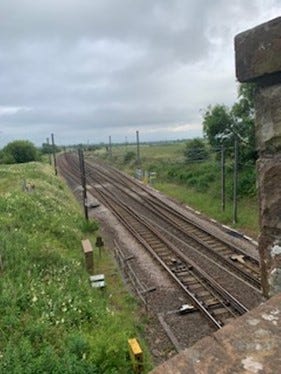


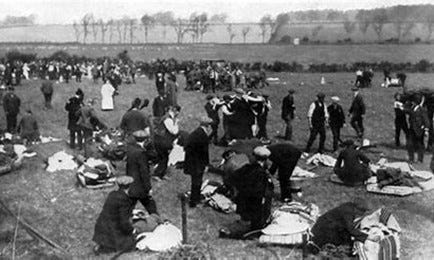
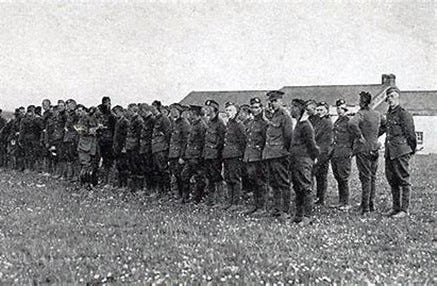

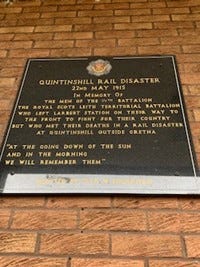
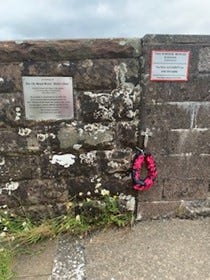
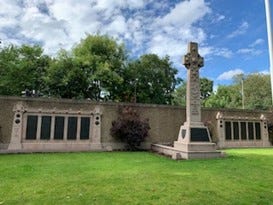
Many thanks Louise, a really excellent piece on this disaster, which I did not know about until now.